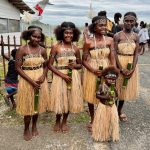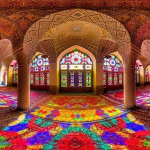Bhutan’s traditional clothing is more than just attire—it is a symbol of the nation’s heritage, spiritual values, and cultural pride. Rooted in centuries-old customs, the distinctive garments of Bhutan reflect the country’s deep connection to its Buddhist identity and the importance of national unity. The traditional dress for men, known as the gho, and for women, the kira, were formalized as national attire during the reign of King Jigme Dorji Wangchuck in the 20th century, as part of a broader effort to preserve Bhutanese identity in the face of modernization.
Clothing in Bhutan is closely tied to its spiritual and social traditions. Colors, patterns, and accessories often reflect social status, regional origin, and religious significance. The mandatory use of traditional dress in schools, government institutions, and official functions helps reinforce a shared sense of belonging and respect for cultural values. Even today, these garments are worn with pride, symbolizing Bhutan’s commitment to its unique identity amidst global change.
For visitors, wearing traditional clothing when entering dzongs, monasteries, or participating in formal ceremonies is a sign of respect and cultural appreciation. Bhutan’s national dress not only preserves tradition but also strengthens the country’s unity and dignity.
Table of Contents
For Men: The Gho
The gho is the traditional and national attire for Bhutanese men. It is a knee-length robe that is wrapped around the body and secured at the waist with a cloth belt called a kera. This creates a large front pouch known as the koma or dhago, often used to carry small items like a wallet, papers, or a mobile phone.
Design and Fabric:
The gho features wide sleeves and is traditionally made from cotton or wool, depending on the season. Formal and ceremonial versions are often crafted from richly patterned handwoven textiles, typically featuring intricate stripes or plaid patterns that reflect regional styles.
Kabney (Scarf):
A kabney is a ceremonial scarf worn over the left shoulder and is mandatory during official or formal occasions. The color of the kabney denotes the wearer’s social or official rank:
- White – Common citizens
- Orange – Ministers and senior officials
- Red – High-ranking monks or government officials
- Yellow – The King and the Je Khenpo (Chief Abbot)
Footwear:
During formal events or in colder seasons, men wear long socks and traditional leather or fabric boots, often elaborately decorated to complement their attire.
How to Wear the Gho and Kabney:
To wear the gho, it is first wrapped tightly around the body and folded to form the front pouch, then secured with the kera at the waist. The hem should fall just below the knees. The kabney is draped over the left shoulder, crossing the chest and hanging down on the right side, ensuring it doesn’t touch the ground.
For Women: The Kira
The kira is the national dress of Bhutanese women, representing elegance, identity, and tradition. It is a full-length rectangular cloth, gracefully wrapped and pinned at the shoulders with ornate brooches called komas, then fastened at the waist with a woven belt known as a kera. The kira is more than just clothing—it symbolizes Bhutanese heritage and is worn with pride, particularly during festivals, religious ceremonies, and official events.
Structure and Layers:
- Inner Layer: A long-sleeved blouse called the wonju is worn underneath.
- Kira: The main garment is folded and wrapped around the body, secured at both shoulders with komas, and tied at the waist with a kera.
- Outer Jacket: A short, open-front jacket called the toego is worn over the kira, adding contrast and layering.
Fabric:
Kiras are traditionally made from handwoven silk or cotton and are often brightly colored with intricate patterns that reflect regional styles or social status. Festive or formal versions use richer weaves and more elaborate designs.
Rachu (Scarf):
The rachu is a narrow, embroidered silk scarf draped over the left shoulder and worn during religious, official, or ceremonial events. It is a symbol of respect and modesty, often showcasing fine weaving and motifs that indicate the wearer’s origin or rank. Proper etiquette requires that it be draped neatly, without touching the ground.
Half Kira:
For everyday wear, Bhutanese women often choose the more practical half kira, a shorter, knee-length version. It is worn with the same wonju and toego, offering comfort and ease of movement while maintaining traditional grace. The half kira is typically wrapped and tied at the waist, similar to a skirt.
How to Wear a Kira:
The full kira is wrapped from one side of the body around to the other, pleated slightly for comfort, and secured at both shoulders with komas. A kera is tightly tied around the waist to hold the fabric in place, ensuring the garment reaches the ankles. The toego is then worn over the blouse and tucked into the waistband.
How to Wear a Rachu:
The rachu is folded lengthwise and draped over the left shoulder so that both ends hang evenly at the front and back. It should be placed neatly and respectfully, never allowed to drag on the ground or hang loosely.
How to Wear a Half Kira:
The half kira is wrapped around the lower body like a skirt and tied with a kera at the waist. It is worn over the wonju and under the toego, offering a neat, semi-formal look suitable for daily wear or casual occasions.
Conclusion: Symbolism and Social Significance
Bhutanese traditional attire is far more than a national dress—it is a living expression of the country’s cultural identity, spiritual beliefs, and social structure. Every fold, fabric, and accessory carries deep symbolism, reflecting centuries of history and Bhutan’s enduring respect for harmony, dignity, and community values. Wearing the gho or kira is not only an act of tradition but also a declaration of pride in Bhutan’s sovereignty and unity.
For travelers, embracing this tradition offers a meaningful way to connect with the local culture. Purchasing a set of traditional attire—whether a gho, kira, or their accessories—not only supports Bhutanese artisans but also allows you to participate respectfully in sacred sites, festivals, or ceremonies. It’s a beautiful souvenir with lasting significance, and a chance to wear a piece of Bhutanese identity with honor.
Want to learn more about Bhutan?
Dive into our Ultimate Travel Guide – your one-stop resource for everything from visa rules and packing tips to Bhutanese cuisine, festivals, traditions, and spiritual landmarks. Explore culture, landscapes, and legends for a truly immersive and unforgettable Himalayan journey.
Are You Ready to Experience Bhutan with YPT?
Join us for a transformative journey through the Land of the Thunder Dragon—where ancient culture, breathtaking landscapes, and mindful adventure await. Discover our upcoming tours and take the first step toward your unforgettable Himalayan escape today.





